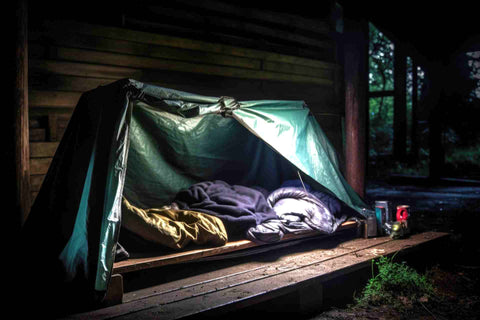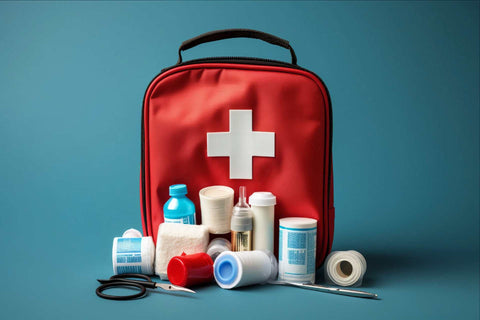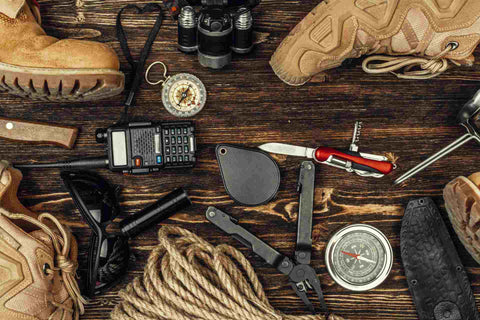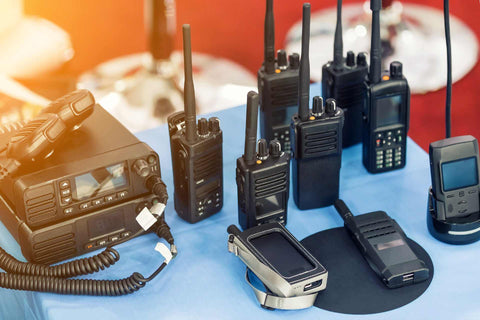Preparing For Doomsday Essential Guide - Steps and Supplies for Ultimate Readiness

The Germanic root of Doomsday signifies "judgment day," yet premonitions or forecasts of looming disaster could distinguish it.
Planning before a crisis episode ensures that people have the necessary equipment, know where to go, and learn how to protect themselves during a crisis.
Doomsday prepping involves measures that states, organizations, networks, or individuals take to better prepare for and adapt to the immediate effects of a calamity, whether human-induced or natural risks.
Some of the various doomsday scenarios waiting to happen at the corner of your home are, but are not limited to, as follows:
Natural Disasters

Natural disasters pose an unparalleled threat to people’s lives, properties, and mental balance. From severe events like earthquakes to calamities that spread quickly without warning, such as pandemics, these catastrophes can cause significant damage from a very small event.
Preparing for such events, known as doomsday prepping, can mitigate the risks and help manage the emotional turmoil they bring.
Types of Natural Disasters
Natural disasters come in various forms, each with its own set of challenges:
Geological Disasters
- Earthquakes
- Landslides or Avalanches
- Volcanic Eruptions
Water-Related Disasters
- Floods
- Tsunamis
Weather-Related Disasters
- Tropical Storms
- Tornadoes
- Snowstorms
- Cyclones
Fire-Related Disasters
- Wildfires
Health-Related Disasters
- Pandemics
Consequences of Natural Disasters
The impact of these disasters can be devastating:
- Physical Harm: Risk of death or injury.
- Property Loss: Damage to homes, possessions, and community infrastructure.
- Emotional Impact: Increased stress and potential for long-term psychological issues.
Emotional Management in Disaster Situations
Managing emotions during a disaster is crucial for immediate survival and long-term recovery:
- Recognize Stress Responses: Understanding that stress reactions are normal can help manage them more effectively.
- Preparation is Key: Adequate doomsday prepping can alleviate some emotional burdens by providing a sense of control and readiness.
By acknowledging the variety and impact of natural disasters, individuals can better prepare for their inevitabilities. Through effective prepping, not only can the physical risks be minimized, but the emotional toll can also be managed, leading to a more resilient response to nature's unpredictability.
Man-Made Threats

In an increasingly complex and interconnected world, the spectrum of potential threats has expanded to include a wide array of man-made dangers. From crimes and cyber-attacks to wars and civil unrest, these threats can have devastating impacts on individuals and communities alike.
This guide aims to navigate the challenging landscape of emergency preparedness, offering practical advice and strategies to ensure safety and resilience in the face of man-made calamities.
Types of Man-Made Threats
Man-made threats encompass various situations and actions that can lead to significant harm or loss:
- Crime and Arson: Acts of theft, vandalism, and deliberate fires.
- Civil Turmoil: Public disorder and violence stemming from protests or civil unrest.
- Terrorist Attacks and War: Organized violence aimed at causing widespread fear or political change.
- Cyber-Attacks: Digital threats targeting critical infrastructure, personal data, and financial systems.
These threats can arise from intentional acts and negligence, each potentially causing significant disruption to lives and communities.
The Path to Effective Emergency Preparedness
Emergency preparedness involves a multifaceted approach, focusing on physical supplies and strategic planning:
- Understanding the Importance: Recognizing that preparedness goes beyond reacting to fear. It's about establishing a foundation of readiness that can mitigate the impact of disasters.
- Essential Supplies: Ensuring access to vital resources like food, water, and medical supplies. These essentials form the backbone of any emergency plan.
- Contingency Planning: Developing thought-out plans that outline steps to take in various emergency scenarios. This includes evacuation routes, communication strategies, and emergency contacts.
- Local Preparedness and Response: Engaging with community efforts to improve resilience. This can involve participating in local drills, contributing to community emergency funds, and staying informed about local hazards.
Facing man-made threats requires vigilance, preparation, and a commitment to safety.
By understanding the risks, gathering necessary supplies, and engaging in comprehensive planning, individuals and communities can enhance their resilience against the unpredictable nature of these dangers.
Preparedness offers peace of mind and is a critical investment in the future well-being of all affected by these man-made challenges.
📣Heads up, doomsday preppers❗
In this section, we will talk about the essential supplies checklist for doomsday preparation (i.e., food, water, shelter, first aid kit, etc.), preparing your home to be resilient against natural disasters, creating a well-thought-out emergency plan, preparing communication backup options, and living sustainably at everyday carry as you begin prepping for when the need to survive emerges.
Essential Supplies Checklist For Doomsday Prepping
In the realm of doomsday prepping, preparation is the cornerstone of survival.
An Essential Supplies Checklist is not just a list; it's a blueprint for resilience against the unpredictable.
This guide is meticulously curated to ensure that, in the face of disaster—whether from natural calamities or man-made threats—you have the necessary resources to sustain life, protect your loved ones, and maintain a semblance of normalcy amidst the chaos.
Covering everything from water and food to shelter and first aid, this checklist is your first step toward comprehensive preparedness for any doomsday scenario.
Essential Supplies Checklist:

✅Food And Water Storage
Food Storage
- Selection: Opt for foods with a long shelf life that require minimal cooking, water, or refrigeration. Shelf-stable items that can withstand temperature fluctuations are ideal.
- Options: Include a variety of non-perishable food, easy-to-heat meals, fiber-rich snacks, tinned fish and meats, fruits and vegetables, oatmeal, pasta or rice, soups, granola or protein bars, and dehydrated meats to meet nutritional needs without generating waste.
- Packaging: Consider the weight of items, especially if you need to move your supplies. Lightweight, compact food parcels offer convenience and portability.
- Go-Packs: Create emergency food packs for each family member to ensure everyone can access sufficient food supplies for at least a few days.
Water Storage
- Quantity: Store at least one gallon of water per person daily, aiming for a three-day minimum supply for immediate needs and, ideally, a two-week supply for extended disruptions.
- Containers: Use FDA-approved food-grade water storage containers to prevent contamination. These containers are designed to keep water safe and clean for drinking, cooking, and hygiene.
- Preparation: Fill containers with clean water and secure them in a cool, dark place to maintain purity. Regularly check and replace stored water to ensure it remains safe for consumption.
✅Shelter And Clothing

Importance of Clothing
- Protection Against Weather: Clothing is your first line of defense against extreme weather conditions, whether a raging snowstorm or a scorching heatwave. The right apparel can mean the difference between life and death.
- Spare Clothing: Always include a spare set of comfortable clothes in your emergency kit. This ensures that you have something dry and warm to change into should your current outfit get wet, damaged, or worn out. This simple step can significantly improve your comfort and morale.
The Necessity of Shelter
- Basic Human Need: A Shelter is a fundamental human need that protects against everyday hazards and severe conditions resulting from natural disasters and man-made crises.
- Protection and Safety: A proper shelter protects from adverse weather, enhancing personal safety and preventing potential health issues or diseases from exposure to harsh conditions.
Access to Cash
- Emergency Funds: In times of crisis, having access to cash is essential. Power outages can render electronic payment methods and ATMs nonfunctional, leaving cash transactions as the only viable option. Keeping a reasonable amount of cash in your emergency kit ensures you can purchase necessities when electronic payment systems are down.
✅First Aid And Medical Supplies

Essential First Aid Supplies
- Plasters
- Triangle bandages
- Crepe-wrapped bandages
- Safety pins
- Disposable sterile gloves
- Tweezers
- Scissors
- Gauze pads
- Cotton swabs
- Medical tape
- Burn ointment
- Hot/cold packs
- Thermometer
- Sterile gloves
- Distilled water
- Pain relievers (for headaches, body pains)
- Medication for fever, nausea, diarrhea
- Prescription medications (as needed)
- Allergy medications (consider family allergies)
Choosing the Right Kit
- Customization: Tailor your kit to specific activities such as hiking, camping, or boating, ensuring you have the right supplies for each context.
- Storage: Select a durable, hard-case container with compartments for organization and easy access. Consider easily carrying the kit in your vehicle or backpack.
- Safety Measures: If you have children, secure the kit with a lock to safeguard sensitive medications.
- Expiration Tracking: Maintain a list of medication expiration dates to ensure all items remain effective and safe.
Placement and Accessibility
- Home and Vehicle: Keep a first aid kit in your home and vehicle to ensure you're prepared wherever an incident occurs.
- Readily Available: Place your kit in an easily accessible location but out of reach of young children.
✅Tools And Equipment

- Flashlight: Vital for power outages or navigating dark environments. Consider including extra batteries or opting for a crank-powered model.
- Whistle: A simple yet effective tool for signaling help when trapped or lost.
- Local Maps: In the event of digital network failures, paper maps can be invaluable for navigation and finding evacuation routes.
- Manual Can Opener: Ensures you can access canned food without electricity, maintaining your food supply.
- Battery-Powered or Hand-Crank Radio: This keeps you informed with emergency broadcasts, weather alerts, and other crucial information when other communication networks are down.
- Power Bank: Charges mobile phones and other small electronic devices, keeping lines of communication open.
- Wrench or Pliers: Useful for turning off utilities such as gas and water to prevent further hazards in disaster scenarios.
Here's a summarized table of the Essential Supplies Checklist for Doomsday Prepping:
|
Category |
Emergency Supplies |
|
Water and Purification |
|
|
Food Supplies |
|
|
Shelter and Warmth |
|
|
First Aid and Medical Supplies |
|
|
Lighting and Power |
|
|
Communication Tools |
|
|
Self-Defense and Security |
|
|
Tools and Equipment |
|
|
Personal Documents and Cash |
|
|
Miscellaneous Items |
|
This table is a comprehensive overview to ensure readiness and resilience in any doomsday scenario.
Steps to Doomsday Prepping
Embarking on the doomsday-prepping journey means more than just a cautious mindset; it is a comprehensive approach that promises survival in the wake of catastrophes and the maintenance of at least partial normalcy.
Whether it is natural disasters, economic collapse, or anything else imaginable, the steps of doomsday prepping can be used by an individual, a family, or a group, with the basic aim of surviving during these uncertain times.
Given below is a step-by-step guide to practicing doomsday prepping to help you build a life full of amazing possibilities that will never let you down.
✅Build A Strong And Resilient Home

Understanding Natural Disasters and Their Impact
- Identify regional threats (storms, floods, earthquakes)
- Assess your home’s vulnerability
- Educate family members on potential natural disasters
Creating a Comprehensive Emergency Plan
- List of necessary supplies (non-perishable food, water, first-aid kits)
- Detailed evacuation routes and safe meeting points
- Communication strategy for staying connected with loved ones
Fortifying Your Home Against Storms and Hurricanes
- Install storm shutters or plywood on windows
- Secure or remove potential flying debris around the property
- Regular maintenance of roofs and structural supports
Preparing for Earthquake Resilience
- Secure heavy furniture and fixtures to the walls
- Install gas shut-off valves
- Evaluate and reinforce the structural integrity of your home
Mitigating the Risks of Floods
- Elevate electrical systems and appliances
- Use flood-resistant building materials for renovations
- Create barriers with sandbags or permanent landscaping features
Protection Against Man-Made Threats
- Enhance home security with high-quality locks and security systems
- Install surveillance cameras at key points
- Use window grates, bars, and secure doors to delay unauthorized entry
Maintaining a Survival Supplies Kit
- Store essential items for survival and comfort
- Rotate supplies to keep them fresh
- Include personal documents and emergency contact information
Developing a Clear Evacuation Plan
- Practice evacuation drills regularly
- Designate a family emergency meeting spot outside the home
- Keep a list of emergency contacts and local shelters
Investing in Home Security Systems
- Choose a burglar alarm that notifies local authorities
- Use surveillance cameras to monitor and record activity
- Consider remote monitoring options for real-time alerts
✅A Well-Thought-Out Evacuation Plan And Bug-Out Bags

Developing an Evacuation Plan
Identify a Safe Meeting Place
- Choose a location outside the evacuation area as a family rendezvous point.
Map Out Evacuation Routes
- Primary and alternate routes to avoid blocked or congested paths.
Create a Communication Plan
- Agree on an alternative means of communication if standard services are unavailable.
Stay Informed
- Monitor official channels for evacuation orders and updates.
Vehicle Preparedness
- Ensure your vehicle has enough fuel to reach your destination.
Designate an External Contact Person
- Choose someone outside the affected area to gather and relay information among family members.
Leverage Text Messaging
- Share mobile numbers for text communication, which can be more reliable in emergencies.
Preparing Bug-Out Bags
Essentials
- Water and purification methods
- Non-perishable food
- First-aid kit
Clothing and Shelter
- Change of clothes suitable for the climate
- Emergency blanket or sleeping bag
Communication Tools
- Battery-powered or hand-crank radio
- Extra batteries or solar chargers
Personal Documents
- Copies of important documents (ID, insurance, medical records)
Navigation Tools
- Maps and a compass or a GPS device
Personal Protection
- Depending on local laws and personal preference, items for self-defense
Miscellaneous
- Multi-tool or Swiss Army knife
- Flashlights and extra batteries
- Personal hygiene items
Communication Backup Options

Emergency communication might incorporate caution and warnings mandates about evacuation, curfews, and other self-defensive activities, data about reaction status, relatives, accessible help, and other issues influencing reaction and recovery.
Communication is fundamental for guaranteeing public security and is powerful when the right messages are conveyed well to the right people at the right time.
The table below outlines various emergency communication devices, detailing their functionalities and advantages. This provides a clear and concise comparison to aid in selecting the most appropriate option for different emergencies and needs.
|
Device |
Description |
Benefits |
|
Two-Way Radio |
Handheld devices that connect on the same frequency within a certain distance, allowing one person to talk while the other listens. |
This system is ideal for quick communication among emergency responders without clogging up cell phone lines. |
|
Citizens Band (CB) Radio |
This system allows short-distance communications on various frequencies, is more complex than a standard two-way radio, and is used for business and personal purposes. |
This source provides good general information and is accessible for commercial and personal use. |
|
Police Scanner |
A device that enables listening to all emergency communications among police, rescue, fire, military, and aircraft industries without the capability to transmit. |
Offers access to vital information during emergencies without the ability to broadcast. |
|
Satellite Telephones |
Utilize orbiting satellites rather than cell phone towers, making them functional in remote areas with little to no internet access. |
This service is beneficial in remote areas; it ensures connectivity even when traditional cell service is unavailable. |
Long-Term Plan For Doomsday Preppers: How To Last?

Creating a long-term plan for doomsday preppers is essential for survival in scenarios where traditional support systems may fail.
Sustainable living through food growing, water harvesting, and building strong community networks forms the cornerstone of a resilient strategy for enduring prolonged emergencies.
Food Growing
Embracing sustainable living through food growing is a vital strategy for doomsday preppers aiming for long-term survival in unpredictable future scenarios.
This approach ensures a continuous supply of fresh produce and enhances self-sufficiency, reducing reliance on external food sources.
Key Considerations:
- Space and Location: Utilize any available space, from a windowsill for herbs to a backyard for vegetables, ensuring at least six hours of direct sunlight daily.
- Water Source: Position your garden near a clean water source for convenient watering.
- Soil Quality: Ensure the soil is well-drained, fertile, and close to your living area for easy access.
- Easy-to-Grow Crops: Start with radishes, beans, peas, and pumpkins, which are among the easiest plants to grow from seed for beginners.
Water Harvesting
Water harvesting represents a critical component of long-term survival strategies for doomsday preppers, allowing for the sustainable collection and utilization of rainwater.
By implementing water harvesting systems, individuals can secure a vital water supply for daily use and emergencies, ensuring resilience and independence from municipal water sources.
Principles and Benefits:
- Capture and Utilize Rainfall: Implement systems to collect rainfall and use it to augment your water supply.
- Environmental and Practical Benefits: Helps reduce water scarcity, mitigates localized flooding, and ensures a backup water supply for emergencies.
- Emergency Supply: Aim to have a two-week water supply, utilizing rainwater harvesting as a primary source.
Community Building And Networks
Fostering strong community networks and building a collaborative emergency response framework are crucial steps for doomsday preppers in enhancing their resilience to disasters.
These initiatives strengthen individual preparedness and ensure collective security and recovery capabilities, highlighting the power of unity in facing the challenges of uncertain futures.
Creating a Robust Support System:
- Emergency Response: Emphasize the importance of a community-based approach to disaster response, with plans covering all aspects of survival and recovery.
- Community Emergency Plan: Develop and tailor a plan to prepare for emergencies affecting your community, fostering a collaborative prepping journey.
Implementing these strategies prepares doomsday preppers for the worst-case scenarios and promotes a lifestyle of self-sufficiency and community resilience that can thrive in any circumstance.
Final Thoughts: Is It Worth It To Begin the Prepping Journey?

Embarking on a prepping journey is not merely a response to fear or paranoia but a strategic approach to resilience and self-sufficiency in unpredictable disasters.
By preparing homes, creating emergency plans, and stocking up on essentials, individuals lay a foundation that significantly enhances their chances of survival and reduces the impact of emergencies on their lives.
This comprehensive guide navigates the intricacies of preparing for both natural and man-made threats, emphasizing the importance of maintaining a well-stocked supply of essentials, developing a strong and resilient home, and cultivating sustainable living practices.
The Value of Prepping
Prepping is a proactive measure that builds on the principle of being ready for any eventuality. It invests in safety, peace of mind, and future security.
Here are key takeaways:
- Self-Reliance and Survival: Prepping is about enhancing your ability to survive and thrive in adverse conditions, relying on your resources and skills.
- Comprehensive Preparedness: From securing a reliable water and food supply to ensuring effective communication during crises, prepping covers all bases to ensure you are never caught off guard.
- Sustainable Living Practices: Learning to grow food and harvest water prepares you for long-term disaster scenarios and promotes an environmentally sustainable and economically efficient lifestyle.
- Community and Safety: Prepping encourages building strong bonds within your community, creating networks of support that enhance collective resilience to disasters.
- Peace of Mind: Knowing you are prepared can significantly reduce anxiety and fear associated with potential disasters, allowing you to face challenges confidently.
In conclusion, the question isn't whether it is worth beginning a prepping journey, but whether you can afford not to be prepared.
Becoming a doomsday prepper is a commitment to taking control of your future, ensuring that you and your loved ones have the best possible chance of overcoming whatever challenges arise.
The peace of mind from knowing you are prepared is invaluable, making the prepping journey worthwhile and essential.
📖 Further Readings:
